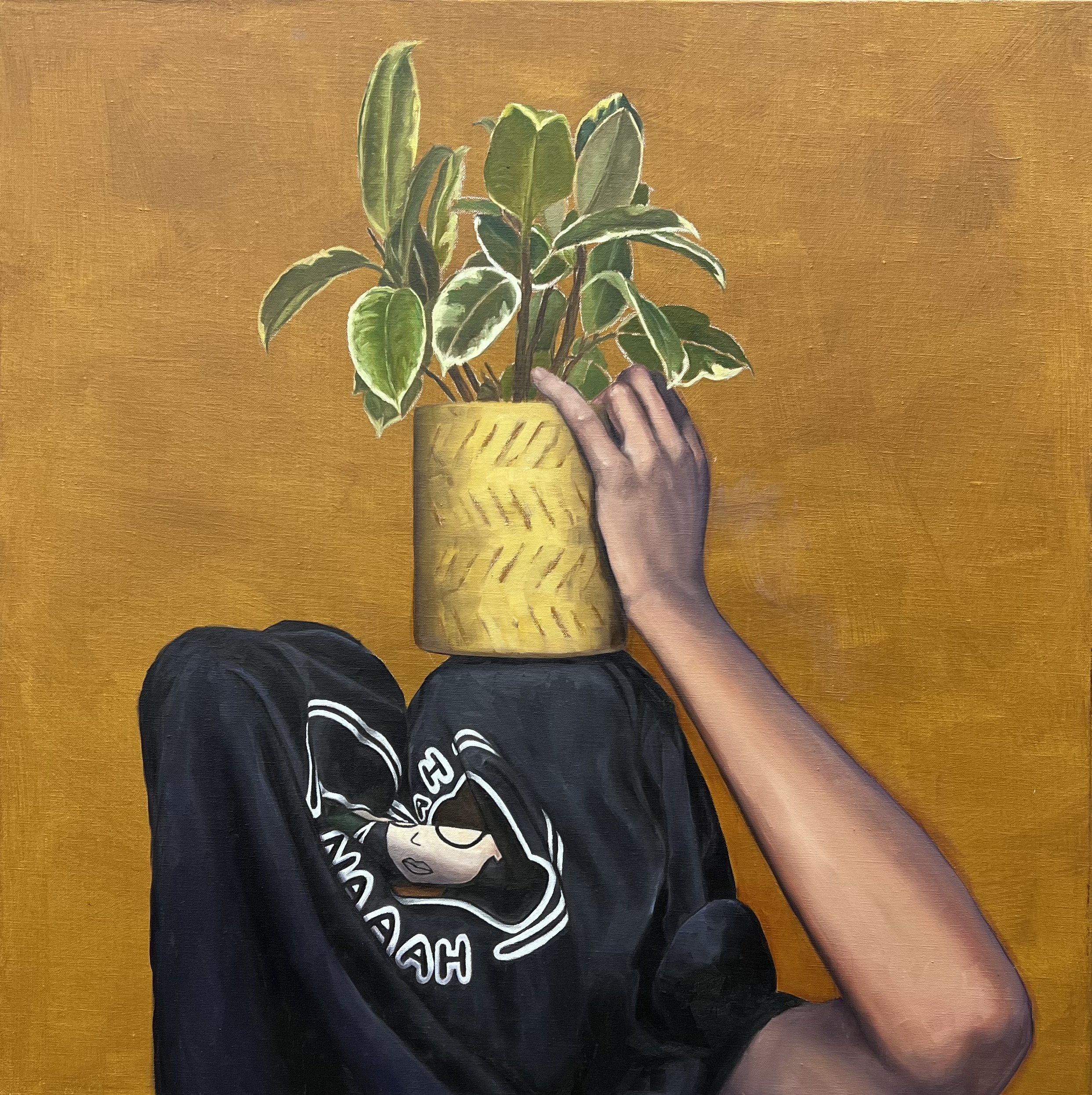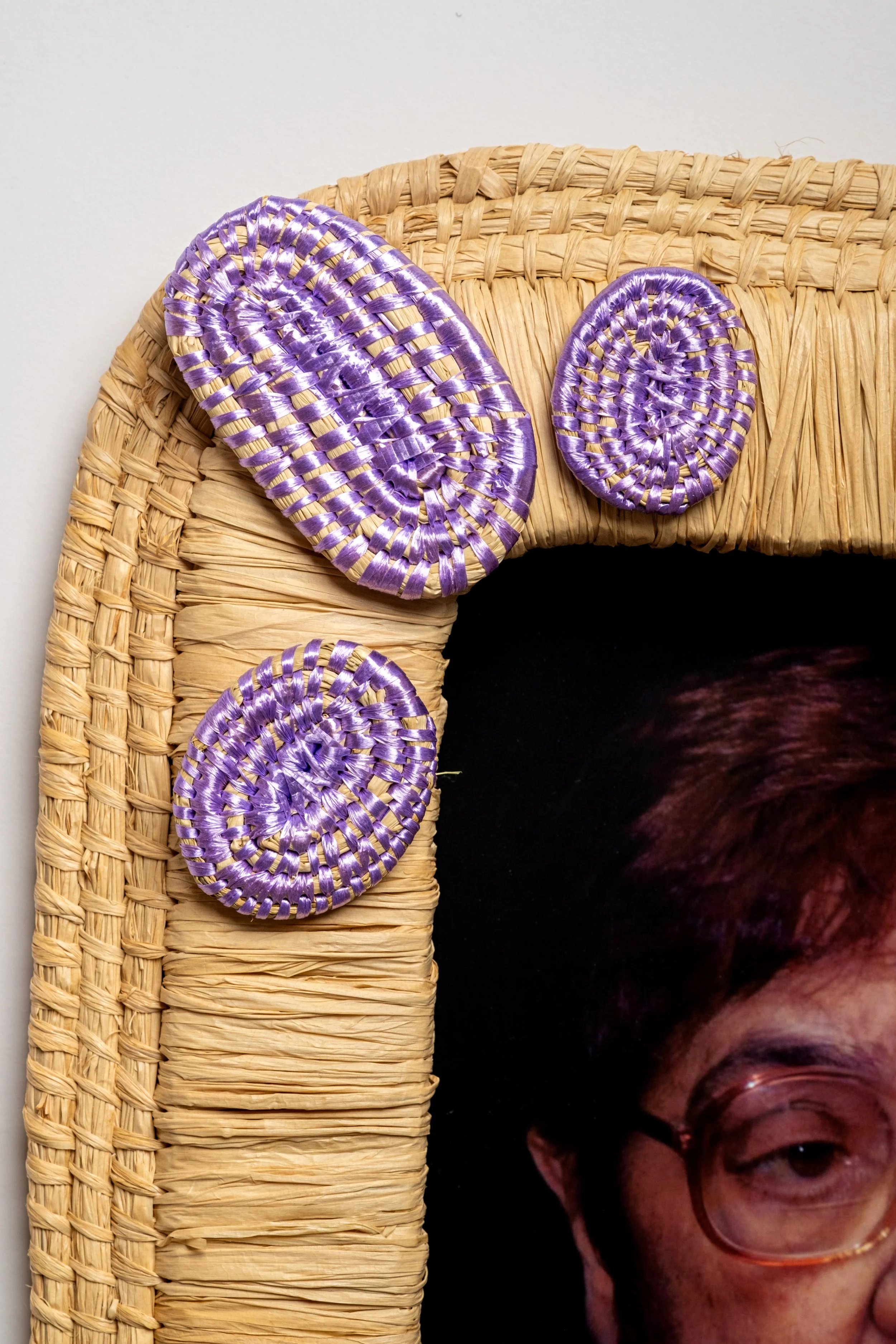
One of many by Carly Tarkari Dodd / Small Acts by Meg Riley & Seirian Kitchener
Carly Tarkari Dodd
Carly Tarkari Dodd is a Kaurna, Narungga and Ngarrindjeri artist and curator based in Tarntanya (Adelaide). She has learnt traditional techniques and puts these to new use to create conceptually and culturally driven contemporary art, often combining weaving with painting and found objects.
Working at JamFactory as the First Nations Engagement Coordinator and Assistant Curator she has worked closely with First Nations artists and art centres on many projects. Highlighting and amplifying Indigenous voices and culture is a strong passion in her curation practice.
Dodd is interested in regalia – the distinctive clothing and ornaments worn by royalty. She is committed to shedding light on the injustices experienced by Aboriginal people, choosing to award recognition to those left out of society.
For the purposes of this essay, the terms ‘Blak Matriarch’, ‘Nanna’ and ‘Aunty’ are interchangeable in a similar way that the familial roles of Aboriginal women are not strictly determined by genetics or marriage. This creates an interwoven network of feminine authority and intrinsic stability as Carly Dodd explores in One of many; a body of work inspired by her Nanna and other matriarchs in her family and community.
Similarly, in my experience within my extended Adnyamathanha family, I’m expected to refer (and be referred to) all senior women using the honorific titles of Aunty and Nanna and from these titles flow reciprocal caring responsibilities.
In stark contrast, Eurocentric monarch matriarchy is an offshoot of its dominant class-based patriarchal system in which women are named and identified through their relationship to male relatives. On one (gloved) hand, power and property is passed in a linear direction (through very shallow gene pools). Male heirs are favoured to inherit castles and titles, but the system will (reluctantly) settle for an eldest daughter in a pinch. This is all scaffolded by laws, customs and rules focusing on gender, birth order, strategic marriage and oddly, excessive regulations about women’s clothing.
This is not all to say that the Blak Matriarchy is a lawless construct, quite the opposite.
Those of us lucky enough to grow up under the canopy of the Blak Matriarchal system will be well versed in the various customs and laws that govern Nanna’s house. Like the chair nobody else is allowed to sit in, often located in the optimal vantage point to keep a subtly watchful eye on all corners of the room. Or the tea-making hierarchy, where a largely unspoken law instigates ebbs and flows in the tide of responsibility depending on which Aunties are present.
Nanna’s house is often the headquarters for important business requiring kids to clear out and eavesdrop with difficulty from another room. Mostly, however, it’s a place of gathering and is open to all family members.
In Carly Dodd’s family, Christmases, birthdays, hot chips and weekly record nights were always at her Nanna’s house as demonstrated by the volume of family photos set around her brown linoleum table. The air at Nanna (or Aunty Neepy)’s place was always alive with music and laughter, and it was truly the heart of the family.
In selecting her Nanna’s portrait for the exhibition, Dodd opted for an elegant black and white image of a teenage Neepy because of the way she felt it reflects her family. Dodd says, “My Aunties all look very different, but in that photo, you can see everyone”.
Dodd was taught traditional Ngarrindjeri weaving with reeds at age 10 by another Blak Matriarch, Aunty Ellen Trevorrow. Refining and modifying her technique since then, she chooses to work mostly with raffia and string to create her distinct, contemporary style. She has framed the collection of beloved Nannas and Aunties in her exhibition with intricate weaving – a decolonising of the showy, baroque framing often favoured by the ruling classes of Europe. The loops, knots and layers within Dodd’s woven frames can be seen as a comment on the interconnecting family ties and enduring strength humbly manifested by the Blak Matriarchy.
Celia Coultard
Celia Coulthard is an Adnyamathanha woman, a mother, an aunty, a daughter, a sister, and an arts administrator based on unceded Peramangk and Kaurna lands

Carly Tarkari Dodd, Veronica Brodie, 2023, raffia, ribbon and photograph. Photo: Connor Patterson.

Carly Tarkari Dodd, Nina Dodd, 2023, raffia, ribbon and photograph. Photo: Connor Patterson.
Meg Riley
Meg Riley is an artist, audio describer and access coordinator. Riley is a painter and drawer, and has worked across other media including bookbinding, embroidery and glassblowing. She paints emotional nudes and portraits and works on commission.
Riley has been exhibiting since 2009 and has been artist-in-residence in Hrisey, Iceland, as well as working in group studios including Holy Rollers, the Mill and Fontanelle.
Riley is disabled and autistic, and this informs her work and how she feels about the world. Riley also works with galleries and museums to make them more accessible.
Seirian Kitchener
Seirian Kitchener is an early career artist working on Kaurna Land, Adelaide, South Australia. She graduated from Adelaide Central School of Art in 2015 with a Bachelor of Visual Art (Honours).
Kitchener’s practice embraces traditional oil painting, and while this pursues a high level of technical skill in classical realism, her paintings seek to push beyond tradition into contemporary methods and concepts. She uses self-portraiture to explore internal experiences and how these reflect the world around her. Her self-portraits quietly observe themes in her own life that may, in turn, reveal collective tensions at play.
She has been actively exhibiting within South Australia since graduating in 2015 and currently works out of Praxis ARTSPACE Studios in Bowden.
Give or take: The unwieldy limbs of self-care and support
Audre Lorde’s 1988 declaration that caring for herself is ‘an act of political warfare’[1] has continued to reverberate through discussions around networks of care and changing notions of self-care in our post-lockdown world. Self-care is self-preservation, is necessary, is healthy. But what if such activities—yoga, cooking a healthy meal, looking after pets and plants—are impossible, only intermittently possible, or simply more trouble than they are worth?
What happens when self-care feels like a battle against the self, when the domestic space is littered with collateral damage— dirty dishes, dying plants and even you, burnt out on the couch? Meg Riley and Seirian Kitchener’s Small Acts revolves around this dialectic between self-care as self-preservation and self-care as burden. In their portraits and self-portraits, hands cradle domestic objects, children. In particular, plants and flowers loom large: live objects drawing, sucking care.
Sara Ahmed has described an individual as ‘one who is not dividable into parts … because others become his parts: they become his arms, his feet, his hands, limbs that are intended to give support to his body’.[2] To extend her idea, what are self-care activities, if not ‘parts’? More crucially, when you practise self-care, are your hobbies or activities supporting you or are you supporting them? In one painting, Kitchener’s entire head is occluded by a pot plant—she has transformed into a support system. Objects, limbs, extensions of the body upon which self-care is enacted, may become vampiric, taking life from the self that practises care. Riley’s meticulous repurposed diamond art piece, for example, is impossible to observe without awareness of the work needed to produce it.
Despite the weight of some of these questions, the works also exude whimsicality. Both Riley and Kitchener depict objects— heavy objects—on heads in humorous ways. Riley’s duplicated book-on-head portraits, the second with glasses slightly askew, recall Joy Hester’s Little girl with book on head (1957) but tend towards playful rather than haunting.
This interplay between playfulness and heaviness echoes the exhibition’s core dialectic. Small Acts captures important moments of care and reflection as it contemplates the balancing act(s) of self-care. Taken together, the paintings constitute a tender invitation to consider the burdens and gifts entailed in small acts of care and how to balance these for ourselves. Perhaps most importantly, the moments of stillness captured by several paintings gesture towards the significance of doing nothing as opposed to something …
Dr Sarah Pearce
Sarah Pearce is a poet, editor, writer and researcher from Tarndanya (Adelaide).
[1] A Burst of Light (1988).
[2] feministkilljoys.com; Willful Subjects (2014)

Seirian Kitchener, I forget to drink water but my plants are thriving, 2023, oil on linen, 76 x 76 cm.

Seirian Kitchener, If only I could photosynthesise, 2023, oil on linen, 76 x 76 cm.

Seirian Kitchener, Easy care, can survive low light conditions, 2023, oil on linen, 76 x 76 cm.

Meg Riley, Sewing for Mum, 2023, 26x31cm, mixed media on canvas.

Meg Riley, Imagined Zen, 2023, acrylic on canvas, 30 x 40 cm.




